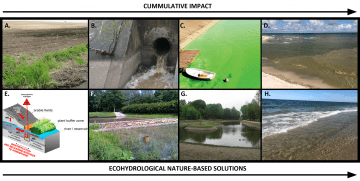Green Deal – Ecohydrological nature-based solutions for improvement of Baltic ecological status
Maciej Zalewski,
European Regional Centre For Ecohydrology PAS,
UNESCO Chair on Ecohydrology and Applied Ecology,
Łódź, Poland
The Sustainable Development Goals of the UN and the European Commission’s Green Deal Strategy, have to be achieved through harmonization of societies needs with the improvement of the biosphere vital resources: clean water, biodiversity, fertile soils and air.
Baltic Sea ecological status has recently become one of important sustainability challenges for Europe, because of the increasing cumulative impact, however it is also a potential generator of opportunities for Green Deal success stories if innovative solutions will be implemented. In case of the Baltic Sea major components of cumulative impact are pollutions from point and non-point source which generate eutrophication, toxic algal blooms and anoxic zones. Due to its complexity, the reduction and compensation of increasing cumulative pollution impact, has to be solved by a new way of thinking e.g. enhancing the role of sewage treatment plants by ecohydrological Nature-Based Solutions.
Ecohydrology as a transdisciplinary scientific paradigm, is based on the assumption that water, and the hydrological cycle is the common denominator and regulator of fundamental ecological processes such as nutrient cycle and energy flow, which in turn determine biodiversity, bioproductivity, ecosystem services available for society and resilience to climate change. Biological structure of ecosystems in turn modify the hydrological cycle to a great extent. According the UNESCO World Water Assessment Program, the terrestrial ecosystems are responsible for more than 60% for stabilization hydrological cycle (Van der Ent et al. 2014). In turn the non-point source pollution and urban stormwater, may generate up to 50% of nutrients load to Baltic from some catchments (Kiedrzynska et al. 2014). That is why the profound understanding the key ecohydrological process and the two-way water/biota interaction serves as a background to use ecosystem processes as a management tool to reduce impact, increase absorbing capacity of ecosystems and enhance catchment sustainability potential, described in Ecohydrological framework by five essential parameters: Water, Biodiversity, Ecosystem Services for Society, Resilience, Cultural Heritage and Education – WBSRCE (Zalewski 2014, 2016). The consciousness of this multidimensional goal for catchment management is a fundamental for transition from a exploitative to sustainable use of resources, including the incorporation of the innovative tools such as Ecohydrological Biotechnologies, known also as “Nature Based-Solutions” (NBS).
Water acts as the mechanism driving the circulation and accumulation of carbon, phosphorus, nitrogen, and other nutrients and pollutants in the catchment (Figure. 1).

Figure 1. An example of cumulative impact: a reduction of a natural land/water ecotone (A) increases the surface flow, especially in periods of heavy rainfall, causing an increase in nutrient load washed up from urban (B.) and agricultural landscape and increasing the risk of toxic algal blooms (C., photo of toxic bloom M. Tarczyńska). The risk can be amplified by unforeseen factors( e.g failure caused by overloaded by stormwater sewage pumping station in Gdańsk (D., Jurata, 25 July 2019, 11:57 am photo: M. Zalewski). An example of Ecohydrological Nature-Based Solutions: a highly effective ecotone zones in agricultural landscape (E.), a Sequential Sedimentation Biofiltration System on the Sokołówka River in Łódź, Poland (F.), for purification of urban stormwater from: roads, parking lots and walkways, adapted for improvement water in urban reservoirs (G.), water retention, ground water recharge, adaptation of the city to climate change (Zalewski et al. 2012, Jurczak et al. 2018) and in catchment scale reducing the risk of toxic algal blooms (H.).
Currently the degradation of terrestrial and water ecosystems is amplified by ongoing climate change. For the involvement of society in actions towards enhancement of catchment ecological status it is necessary to rise society’s consciousness and awareness of the basic processes in the ecosystems. Therefore for achieving sustainable future by Green Deal Strategy the transition from the current sociocentric/mechanistic paradigm, formulated at the beginning of the industrial age to the evolutionary-ecosystemic. According to the sociocentric-mechanistic approach, the biosphere is a “black box”, a system which gives unlimited resources and receives and absorbs all generated pollutions and waste. The energy and matter is gained through unrenewable resources – fossil fuels. On the contrary, in the new evolutionary-ecosystemic approach, more emphasis is put on the sustainable usage of renewable resources by Circular Economy. The word “evolutionary” expresses the understanding that the biosphere and the ecosystems are constantly changing and with the severe modification to the natural processes which occur in the Anthropocene, each and everyone of us to various extent decides, whether we will use the Earth’s resources like It’s a “black box” providing nonlimited resources and absorbing every dose of pollutants, this will be leading to an inevitable catastrophe, or will we be a disciplined crew, rationally using the potential of the magnificent Space Ship “EARTH”.
The urgent necessity for the transition from sociocentric-mechanistic paradigm to evolutionary-ecosystem has been noticed the European Commission’s Committee of Regions (COR) in a atrategic document “Fitness check of the Water Framework Directive, Groundwater Directive, Environmental Quality Standards Directive and Floods Directive” (https://cor.europa.eu/en/our-work/Pages/OpinionTimeline.aspx?opId=CDR-541-2020).
Email: maciej.zalewski@biol.uni.lodz.pl; m.zalewski@erce.unesco.lodz.pl
Expert article 2861
> Back to Baltic Rim Economies 1/2021
To receive the Baltic Rim Economies review free of charge, you may register to the mailing list.
The review is published 4-6 times a year.
